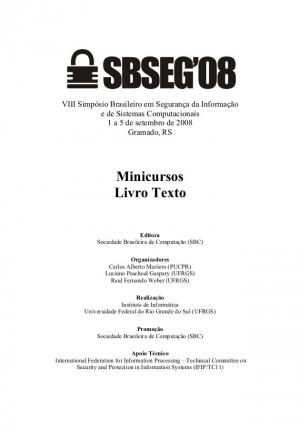Minicursos do VIII Simpósio Brasileiro de Segurança da Informação e de Sistemas Computacionais
Palavras-chave:
Segurança da Informação, Sistemas Computacionais, Minicursos do SBSeg 2008, SBSeg 2008Sinopse
O Simpósio Brasileiro em Segurança da Informação e de Sistemas Computacionais (SBSeg) é um evento científico promovido anualmente pela Sociedade Brasileira de Computação (SBC) e representa o principal fórum no país para a apresentação de pesquisas e atividades relevantes ligadas à segurança da informação e de sistemas
Este livro reúne os quatro capítulos produzidos pelos autores das propostas de minicursos aceitas para apresentação no SBSeg 2008.
O Capítulo 1, "Gestão de Riscos", apresenta aspectos teóricos e práticos da gestão de riscos, fornecendo aos alunos uma base para desenvolverem seus próprios projetos. Espera-se, portanto, com esse curso, contribuir para um melhor entendimento da metodologia de gestão de riscos.
O Capítulo 2, "Segurança em Redes Mesh: Tendências, Desafios e Aplicações", apresenta, de maneira teórica, os principais problemas de segurança em redes mesh e a discussão de soluções propostas para solucioná-los. O capítulo tem três focos principais: a contextualização das redes mesh; o estado da arte e as questões de segurança em redes em malha sem fio, com seus desafios e deficiência e as principais propostas encontradas na literatura.
O Capítulo 3, "Tráfego Internet não Desejado: Conceitos, Caracterização e Soluções", apresenta o universo do tráfego não desejado, incluindo definições, classificação e os motivos que explicam seu surpreendente crescimento. Além disso, aponta as deficiências das soluções existentes e recentes para detecção de tráfego indesejado. Por fim, este capítulo apresenta potenciais soluções e enumera temas de pesquisa em aberto sobre tráfego não desejado na Internet.
O Capítulo 4, "Virtualização: Conceitos e Aplicações em Segurança", apresenta os fundamentos conceituais sobre máquinas virtuais, discute as vantagens e desvantagens no uso de máquinas virtuais, explora as principais possibilidades de uso de máquinas virtuais na área de segurança de sistemas e expõe alguns exemplos de ambientes de máquinas virtuais de uso corrente.
Capítulos
-
1. Gestão de Riscos
-
2. Segurança em Redes Mesh: Tendências, Desafios e Aplicações
-
3. Tráfego Internet não Desejado: Conceitos, Caracterização e Soluções
-
4. Virtualização: Conceitos e Aplicações em Segurança
Downloads



